Effect of Preheating Temperature on the Microstructure and Tensile Properties of 6061 Aluminum Alloy Processed by Hot Rolling-Quenching
Abstract
:1. Introduction
2. Materials and Methods
3. Results and Discussion
3.1. Ageing Hardening and Mechanical Properties
3.2. Microstructure and Strengthening Effect
4. Conclusions
Author Contributions
Funding
Acknowledgments
Conflicts of Interest
References
- Rajabi, F.; Zarei-Hanzaki, A.; Eskandari, M.; Khoddam, S. The effects of rolling parameters on the mechanical behavior of 6061 aluminum alloy. Mater. Sci. Eng. A 2013, 578, 90–95. [Google Scholar] [CrossRef]
- Rao, P.N.; Viswanadh, B.; Jayaganthan, R. Effect of cryorolling and warm rolling on precipitation evolution in Al 6061 alloy. Mater. Sci. Eng. A 2014, 606, 1–10. [Google Scholar] [CrossRef]
- Akhtar, F. Microstructure evolution and wear properties of in situ synthesized TiB2 and TiC reinforced steel matrix composites. J. Alloys Compd. 2008, 459, 491–497. [Google Scholar] [CrossRef]
- Huang, C.Q.; Diao, J.P.; Deng, H.; Li, B.J.; Hu, X.H. Microstructure evolution of 6016 aluminum alloy during compression at elevated tomperatures by hot rolling emulation. Trans. Nonferrous Met. Soc. China Engl. Ed. 2013, 23, 1576–1582. [Google Scholar] [CrossRef]
- Odoh, D.; Mahmoodkhani, Y.; Wells, M. Effect of alloy composition on hot deformation behavior of some Al-Mg-Si alloys. Vacuum 2014, 149, 248–255. [Google Scholar] [CrossRef]
- Berndt, N.; Frint, P.; Wagner, F.X. Influence of Extrusion Temperature on the Aging Behavior and Mechanical Properties of an AA6060 Aluminum Alloy. Metals 2018, 8, 51. [Google Scholar] [CrossRef]
- Fan, X.B.; He, Z.B.; Yuan, S.J.; Lin, P. Investigation on strengthening of 6A02 aluminum alloy sheet in hot forming-quenching integrated process with warm forming-dies. Mater. Sci. Eng. A 2013, 578, 221–227. [Google Scholar] [CrossRef]
- Sha, G.; Wang, Y.B.; Liao, X.Z.; Duan, Z.C.; Ringer, S.P. Influence of equal-channel angular pressing on precipitation in an Al–Zn–Mg–Cu alloy. Acta Mater. 2009, 57, 3123–3132. [Google Scholar] [CrossRef]
- Roven, H.J.; Liu, M.; Werenskiold, J.C. Dynamic precipitation during severe plastic deformation of an Al–Mg–Si aluminium alloy. Mater. Sci. Eng. A 2008, 483–484, 54–58. [Google Scholar] [CrossRef]
- Cai, M.; Field, D.P.; Lorimer, G.W. A systematic comparison of static and dynamic ageing of two Al–Mg–Si alloys. Mater. Sci. Eng. A 2004, 373, 65–71. [Google Scholar] [CrossRef]
- Rao, P.N.; Jayaganthan, R. Effects of warm rolling and ageing after cryogenic rolling on mechanical properties and microstructure of Al 6061 alloy. Mater. Des. 2012, 39, 226–233. [Google Scholar]
- Abolhasani, A.; Zarei-Hanzaki, A.; Abedi, H.R.; Rokni, M.R. The room temperature mechanical properties of hot rolled 7075 aluminum alloy. Mater. Des. 2012, 34, 631–636. [Google Scholar] [CrossRef]
- Fan, X.B.; He, Z.B.; Yuan, S.J. Deformation behavior of 5A06 aluminum alloy sheet for rapid gas forming at elevated temperature. Trans. Nonferrous Met. Soc. China Engl. Ed. 2012, 22, s389–s394. [Google Scholar] [CrossRef]
- Fan, X.B.; He, Z.B.; Zhou, W.X.; Yuan, S.J. Formability and strengthening mechanism of solution treated Al-Mg-Si alloy sheet under hot stamping conditions. J. Mater. Process. Technol. 2016, 228, 179–185. [Google Scholar] [CrossRef]
- Fan, X.B.; He, Z.B.; Zheng, K.; Yuan, S.J. Strengthening behavior of Al-Cu-Mg alloy sheet in hot forming-quenching integrated process with cold-hot dies. Mater. Des. 2015, 83, 557–565. [Google Scholar] [CrossRef]
- Yuan, S.J.; Fan, X.B.; He, Z.B. Hot forming-quenching integrated process with cold-hot dies for 2A12 aluminum alloy sheet. Procedia Eng. 2014, 81, 1780–1785. [Google Scholar] [CrossRef]
- Fan, X.B.; Shao, F.; Zheng, K.L.; Wang, Z.B.; Yuan, S.J. Formability and microstructure of AA6061 Al alloy tube for hot metal gas forming at elevated temperature. Trans. Nonferrous Met. Soc. China Engl. Ed. 2012, 22, s364–s369. [Google Scholar]
- Utsunomiya, H.; Tada, K.; Matsumoto, R. Die motion control for die-quench forging process of AA6061 aluminum alloys. CIPR Ann. 2016, 65, 297–300. [Google Scholar] [CrossRef]
- Wang, L.; Strangwood, M.; Balint, D.; Lin, J.; Dean, T.A. Formability and failure mechanisms of AA2024 under hot forming conditions. Mater. Sci. Eng. A 2011, 528, 2648–2656. [Google Scholar] [CrossRef]
- Mohamed, M.S.; Foster, A.D.; Lin, J.; Balint, D.S.; Dean, T.A. Investigation of deformation and failure feature in hot stamping of AA6082: Experimentation and modeling. Int. J. Mach. Tools Manuf. 2012, 53, 27–38. [Google Scholar] [CrossRef]
- Wang, T.; Zhou, X.; Li, Y.F.; Zhang, Z.Q.; Le, Q.C. Effect of Rolling Temperature on the Microstructure and Mechanical Properties of Mg-2Zn-0.4Y Alloy Subjected to Large Strain Rolling. Metals 2018, 8, 937. [Google Scholar] [CrossRef]
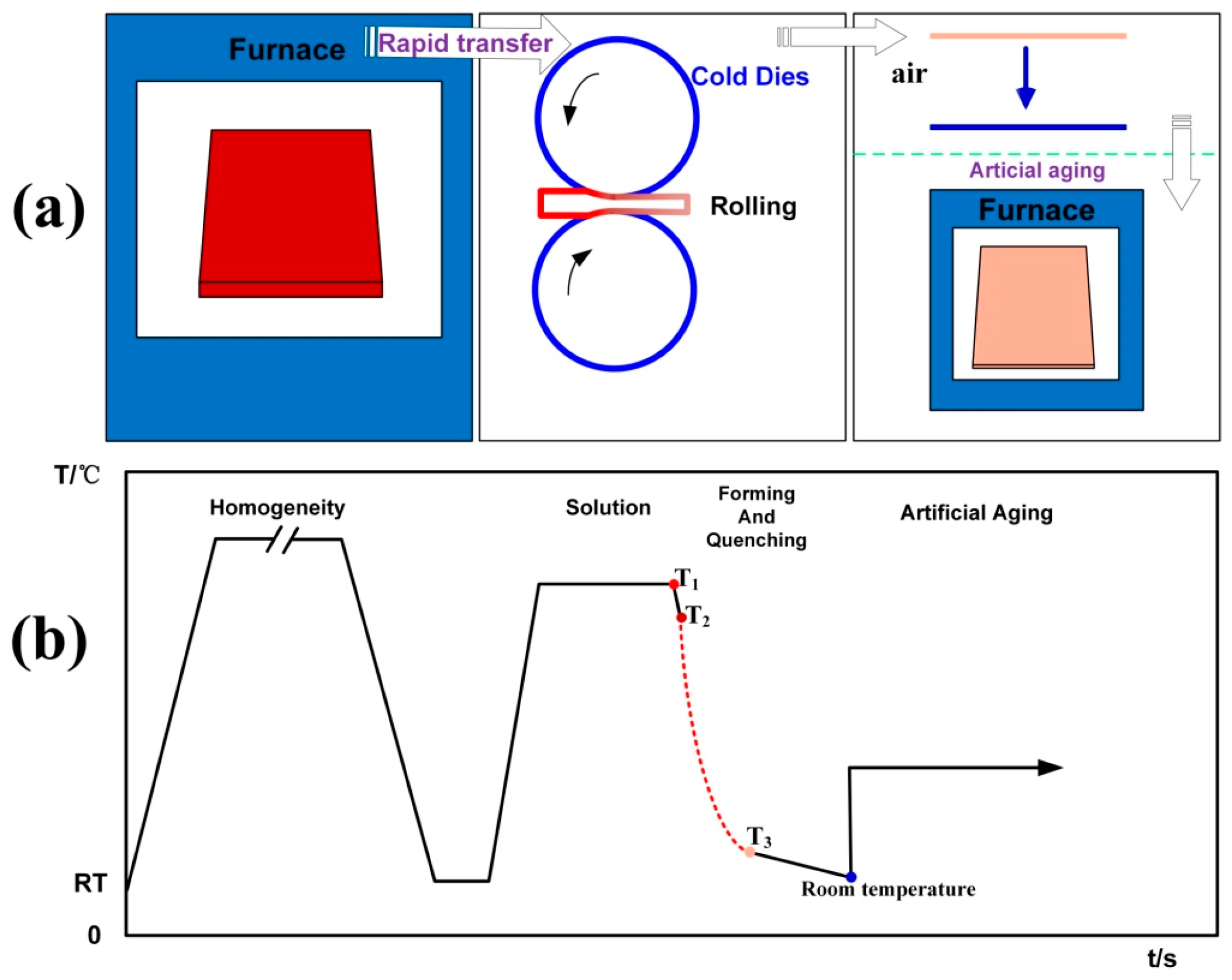


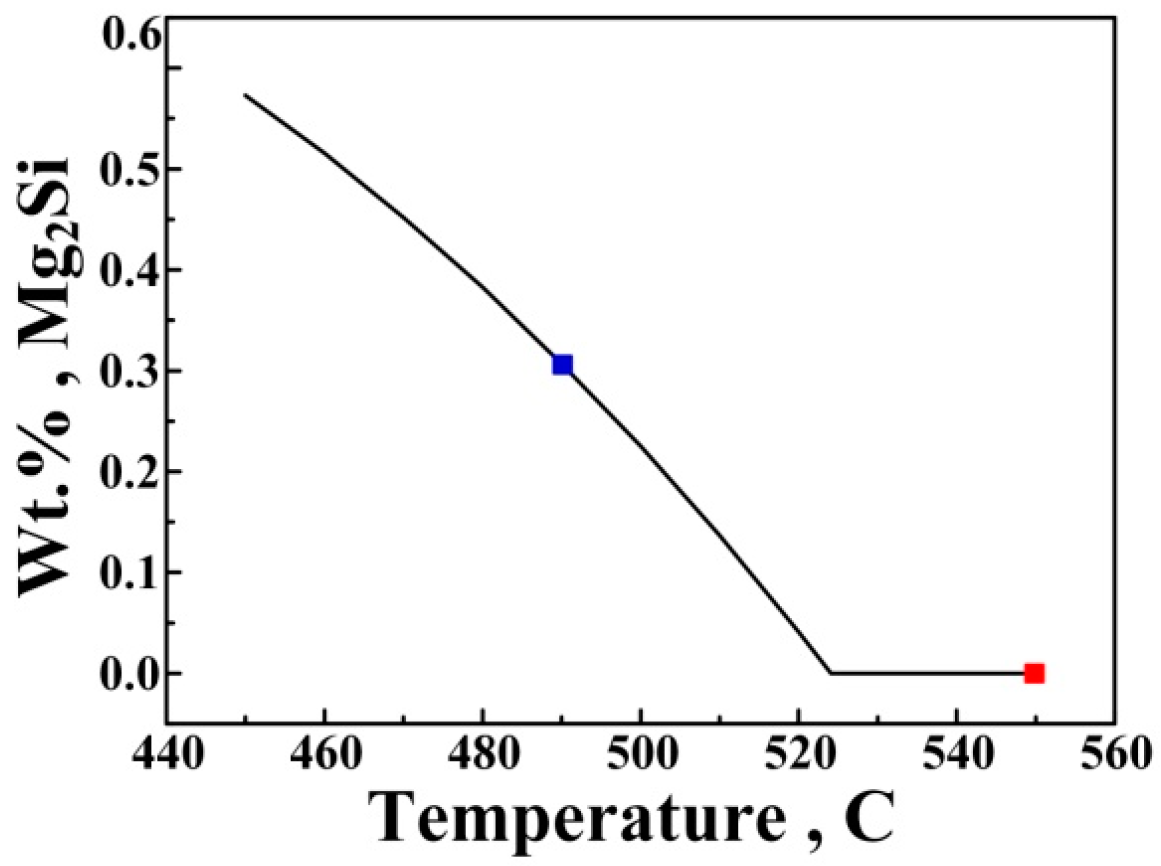

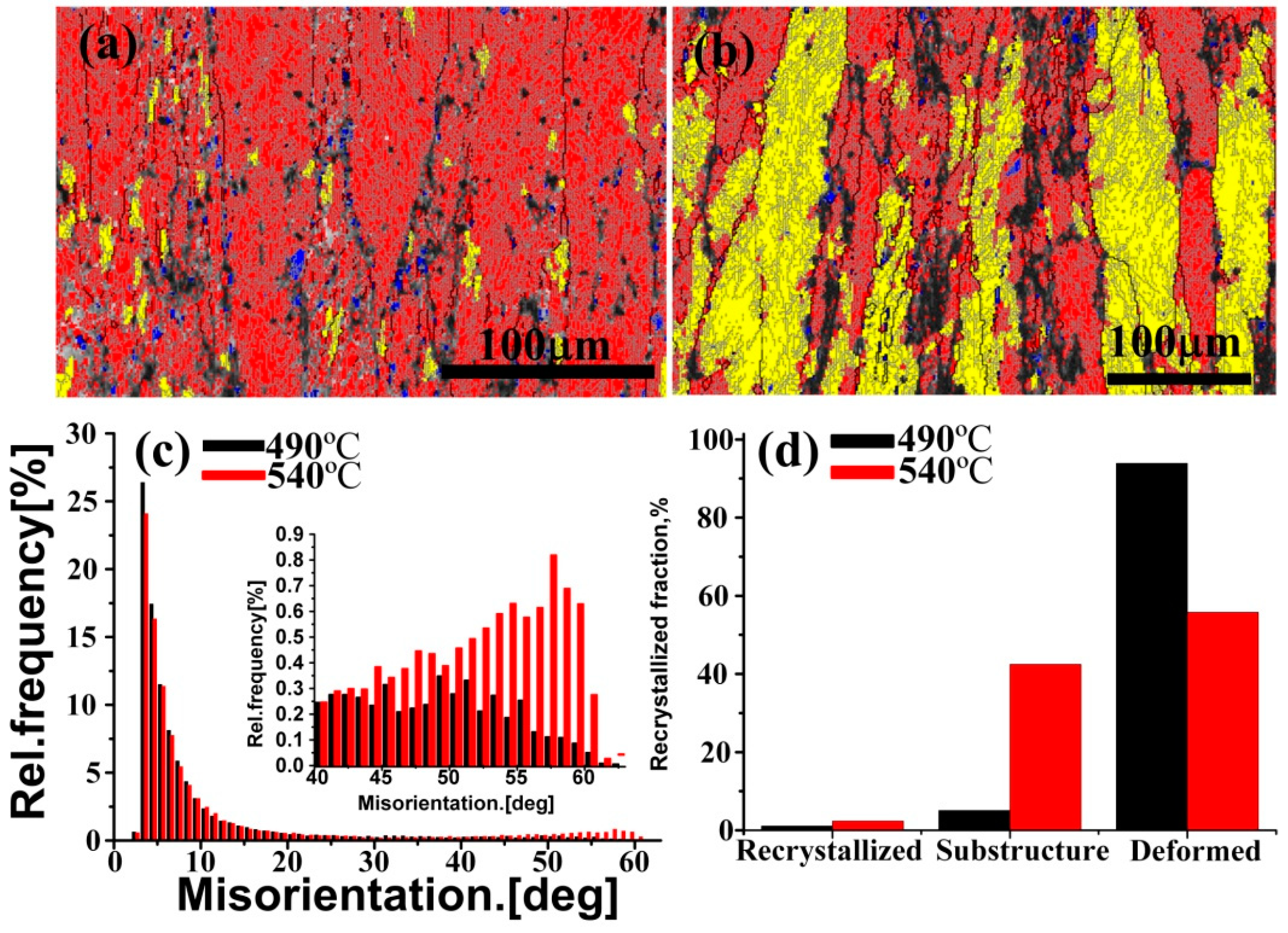

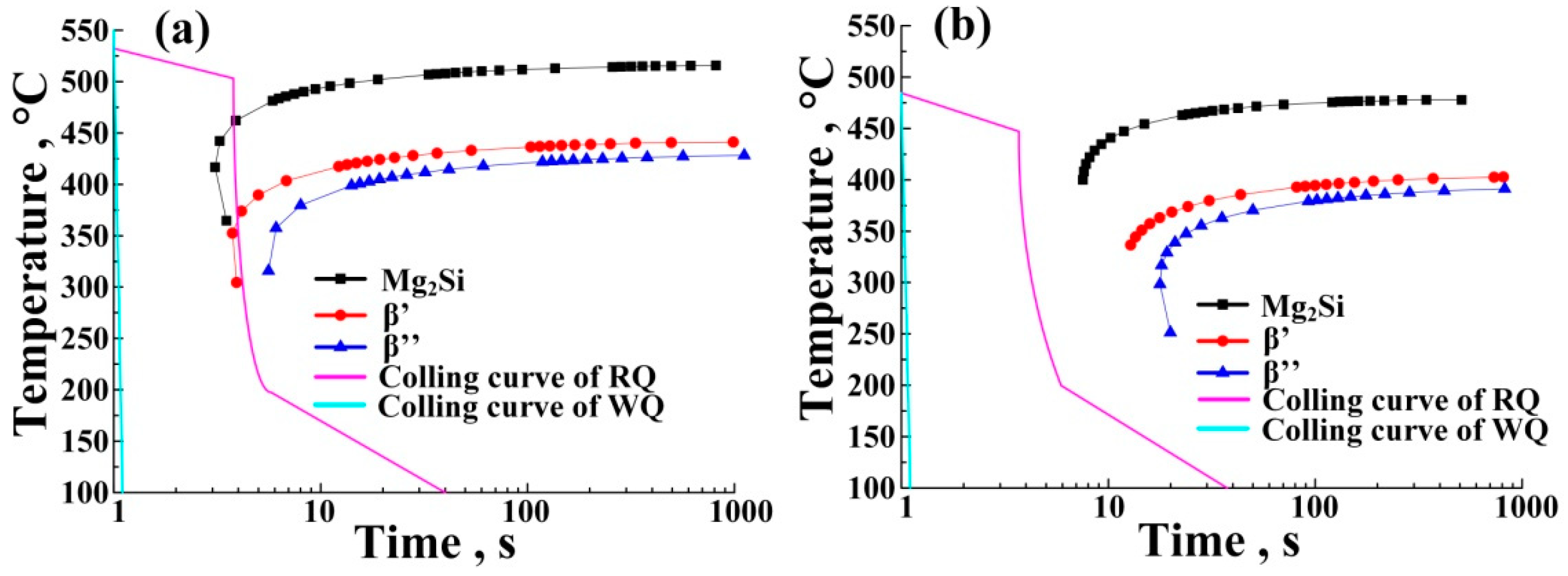
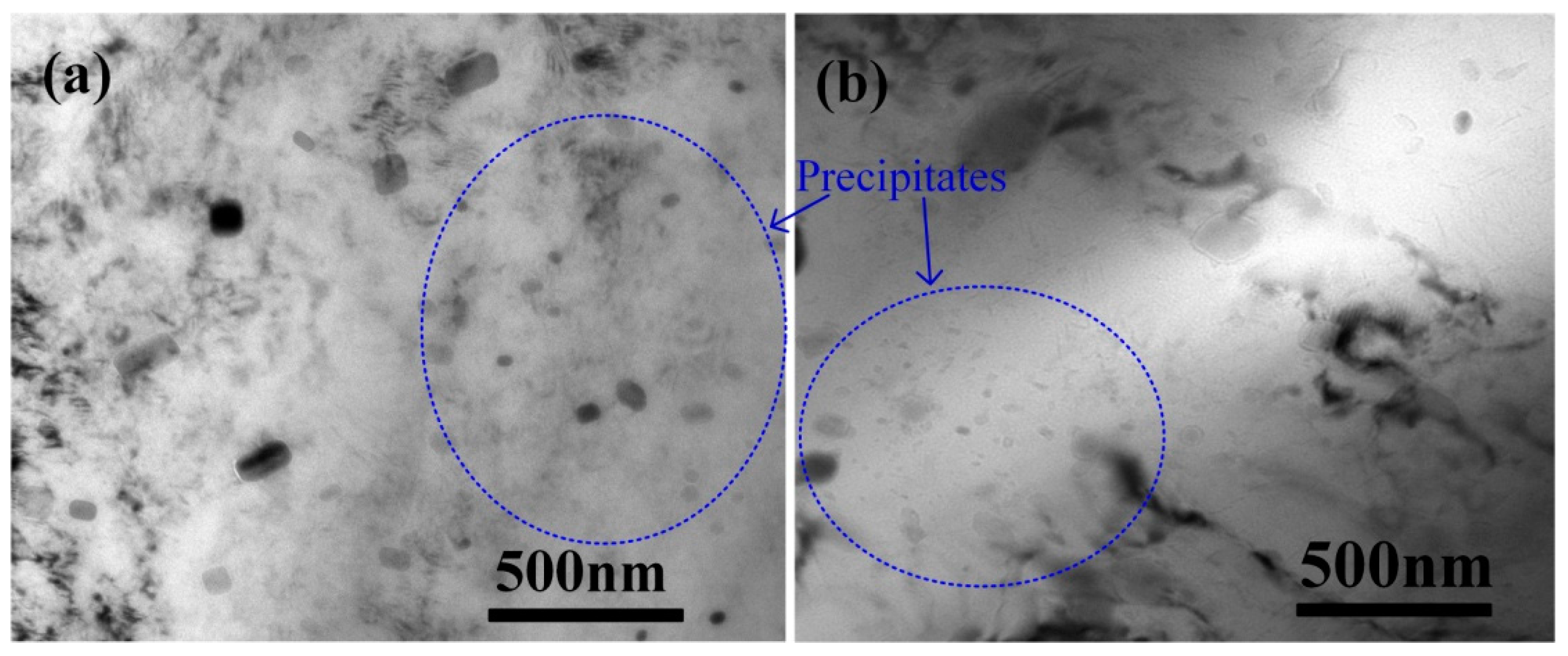
| Element | Mg | Si | Fe | Cu | Mn | Cr | Zn | Ti | Al |
|---|---|---|---|---|---|---|---|---|---|
| wt. % | 0.87 | 0.55 | 0.59 | 0.36 | 0.15 | 0.17 | 0.23 | 0.16 | Bal. |
| Preheating Temperature | T1 | T2 | T3 |
|---|---|---|---|
| 490 | 490 | 450 ± 5 | 170 ± 5 |
| 540 | 540 | 500 ± 5 | 185 ± 5 |
© 2019 by the authors. Licensee MDPI, Basel, Switzerland. This article is an open access article distributed under the terms and conditions of the Creative Commons Attribution (CC BY) license (http://creativecommons.org/licenses/by/4.0/).
Share and Cite
Zhao, Q.-L.; Shan, T.-T.; Geng, R.; Zhang, Y.-Y.; He, H.-Y.; Qiu, F.; Jiang, Q.-C. Effect of Preheating Temperature on the Microstructure and Tensile Properties of 6061 Aluminum Alloy Processed by Hot Rolling-Quenching. Metals 2019, 9, 182. https://doi.org/10.3390/met9020182
Zhao Q-L, Shan T-T, Geng R, Zhang Y-Y, He H-Y, Qiu F, Jiang Q-C. Effect of Preheating Temperature on the Microstructure and Tensile Properties of 6061 Aluminum Alloy Processed by Hot Rolling-Quenching. Metals. 2019; 9(2):182. https://doi.org/10.3390/met9020182
Chicago/Turabian StyleZhao, Qing-Long, Tong-Tong Shan, Run Geng, Yang-Yang Zhang, Hong-Yun He, Feng Qiu, and Qi-Chuan Jiang. 2019. "Effect of Preheating Temperature on the Microstructure and Tensile Properties of 6061 Aluminum Alloy Processed by Hot Rolling-Quenching" Metals 9, no. 2: 182. https://doi.org/10.3390/met9020182
APA StyleZhao, Q.-L., Shan, T.-T., Geng, R., Zhang, Y.-Y., He, H.-Y., Qiu, F., & Jiang, Q.-C. (2019). Effect of Preheating Temperature on the Microstructure and Tensile Properties of 6061 Aluminum Alloy Processed by Hot Rolling-Quenching. Metals, 9(2), 182. https://doi.org/10.3390/met9020182






